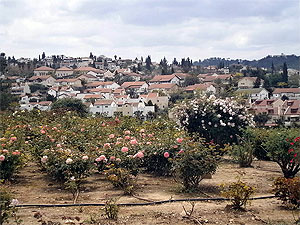Beit Shemesh
Beit Shemesh (Hebrew בית שמש - House of the Sun / Temple of the Sun God Šamaš, by transfer from the Hebrew are different spellings; Arabic بيت شيمش, DMG Bayt Simis, Tell Beit Shemesh: Arabic عين شمس, DMG ʿ Ayn Sams; Greek Βαιθσαμυς; Bethsames latin ) is a town in Israel in the district of Jerusalem on the railway line from Tel Aviv to Jerusalem.
History
Antiquity
Beit Shemesh is named after an earlier settlement of the same name, which lies just west of the present city; the tell was excavated in the early 20th century. This city, which was inhabited by Canaanites, among others, and Hyksos, goes back to the 18th century BC. In the Bible, Beit Shemesh is mentioned several times, eg in connection with the conquest of the country by the Israelites (Josh. 21.16 LUT ) and the return of the stolen Ark by the Philistines (1 Sam 6:12 LUT). The place was still inhabited in Roman times; to 1300, a caravanserai was built in its place.
Since 1950
The modern Beit Shemesh was founded in 1950 as a development town and was planned as an urban center for the northern Shephelah region. The use of the first settlers in the reforestation emerged around Beit Shemesh extensive pine forests.
For the development of the city, the situation had a negative impact: Since the new building of the Tel Aviv- Jerusalem highway Beit Shemesh is located off the main thoroughfare. The Tel Aviv- Jerusalem railway line was also used by the Israeli Railways for many years any more. Exists only since 2003, a regular train to Tel Aviv; regular passenger services to Jerusalem was resumed in April 2005 after extensive renovation measures.
On 25 June 1991 Beit Shemesh received the status of a municipality.
Due to the location Beit Shemesh stagnated for a long time and had in the 1990s only about 25,000 inhabitants. Thereafter, the city grew significantly due to the influx of new immigrants. In 2006, Iglesias had 69,500 inhabitants. A portion of the inhabitants of Beit Shemesh are commuters who work in Jerusalem.
One important industry is the cultivation of wine; in the area of Beit Shemesh are, inter alia, the vineyards of the monastery Cremisan.
The city is a stronghold of the ultra-Orthodox Judaism. The end of 2011 there were actions against the ultra-Orthodox, gender segregation on the street, on the bus and elsewhere to introduce in the public space, to national protests.
Around 10,000 from across the country In rice, including many religious Israelis and prominent politicians, protested in the city and expressed solidarity with the critics of fundamentalist trends. President Shimon Peres supported the protest and praised the police, " the fight for basic equality in Beit Shemesh ." In his opinion, should all " get up a minority that behaves in an unprecedented way. " In the country against
Hundreds of ultra-Orthodox Israelis rioted in Beit Shemesh on December 29 after their planned rally could not take place. Then they threw stones, set fire to trash cans and blocking traffic.
Population
The Israeli Central Bureau of Statistics indicates when the census of 22 May 1961 May 19, 1972, June 4, 1983, November 4, 1995 and December 28, 2008, the following for Beit Shemesh population figures:
Mayor
Twinning
- Germany Nordhausen, Germany; since 1992
- Croatia Split, Croatia
- People's Republic of China Hangzhou, China
- United States Cocoa, Florida, United States; since 2007
- United States Ramapo, New York, United States of America








